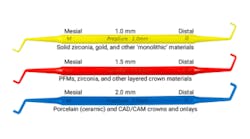Are your crown preps prepped enough?: A few tricks to ensure adequate occlusal reduction
HAVE YOU EVER RECEIVED A PHONE CALL from your laboratory technician with the dreaded news that you didn't reduce one of your crown preps enough? I would be so bold as to say that those of us who practice restorative dentistry have all gotten that news at least once. Some of us have gotten that news more than we would like to admit.
More and more all-ceramic restorations are being fabricated, and preparation design and occlusal reduction are essential for their material strength and longevity. When bonded, e.max (Ivoclar Vivadent Inc.) restorations have an average flexural strength of 500 MPa at 1 mm thickness, and some zirconia restorations can be strong and durable at 0.5 mm thickness.
What happens if we underreduce our preparations? We only have five options when this happens:
- Have the patient return to reprepare the tooth and make a new final impression. Although this is ideal, it may be time-consuming and costly to the dental practice.
- Ask the laboratory to fabricate the crown at an ideal thickness and plan to reduce the opposing tooth. This option may work, but then we have to ask or inform the patient about removing tooth structure from a tooth on the opposing arch. What happens if the patient is reluctant to have this done or if the tooth is sensitive during enameloplasty? This option has some inherent challenges, including the potential breakdown of the patient's trust. If I had a nickel for every time I met a patient who stated that his or her previous dentist delivered a crown that didn’t fit and then shaved down the other teeth, my dental loans would be paid off!
- Ask the laboratory to fabricate a reduction coping. At the insertion appointment, the reduction coping will be placed on your crown preparation, and it will serve as a guide to reduce any underreduced tooth structure, and then the crown will be fitted to the tooth. Beside the first option, this is probably best. It saves the patient and the office an extra appointment to reprepare the tooth, but care must be taken to reduce the proper amount of tooth structure. If the tooth structure is overreduced, despite using the reduction coping, the fit between the crown and the tooth might not be intimate. Depending on where the underreduction took place, this can result in reduced retention of the crown or an increased dependency on the strength of your cement. An additional downside to this option is that fabricating a reduction coping usually requires an added lab fee, which increases lab costs.
- Ask the laboratory to make the crown anyway. This may result in areas within the crown that are inherently weak and may reduce the crown’s longevity. (Don't shoot the messenger . . . it happens!)
- Eliminate all of these issues and reduce the appropriate amount of tooth structure, based on the needs of the proposed restorative material. There are some tools that we can use to ensure that the appropriate amount of tooth structure is reduced.
Occlusal and incisal reduction burs
Burs (WRC Depth Limiting System, Brasseler USA) are available that have cutting edges at specific depths to enable dentists to reduce tooth structure to a predetermined depth. These burs limit the potential for overreduction. Depth cuts can be placed in the tooth, or alternatively, the entire occlusal or incisal reduction can be completed with these burs.
Pros:These burs are available in multiple depths, and they offer a lot of versatility for a variety of proposed restorative materials. The depth-limiting feature prevents overpreparation of tooth structure. These burs are autoclavable and reusable.
Cons:They are diamond burs, so there is an added expense to the practice.
Depth reduction tabs
Flex Tabsfrom Kerr are flexible, disposable tabs of various thicknesses (1.0 mm, 1.5 mm, 2.0 mm) that can be placed between the crown prep and the opposing dentition to determine when the reduction of tooth structure is adequate for full-coverage restorations. They are single-use and disposable.
Pros:The tabs can be cut to the desired width. They are relatively low-cost. They are helpful to identify the location of underprepared tooth structure; a piece of articulating paper can be wrapped around a tab to mark where the preparation requires additional adjustment.
Cons:These tabs are flat, and preparations generally have primary anatomy built into them, so care must be taken to ensure that any resistance from the tab is due to inadequate reduction, rather than the flexible tab getting caught traveling over cusps. Another con is that these are not useful in all partial-coverage restorations, where some occlusal tooth structure is left intact.
Depth reduction guides
PrepSurecrown prep guides (ContacEZ) are autoclavable plastic instruments designed to confirm ideal tooth preparation for crowns and onlays. These instruments come in a pack of three: 1 mm, 1.5 mm, and 2.0 mm reduction. One side measures the mesial half of a preparation, and the other side measures the distal half of the preparation. The measuring tip can be placed into reduction grooves to ensure proper reduction, or it can be placed between the prepared tooth structure and the opposing tooth after occlusal reduction has taken place. There is a bend in the shank of the instrument, which facilitates measuring all aspects of the preparation. The PrepSure crown prep guides are intended to glide between the prepared and opposing tooth structure. If a PrepSure guide doesn't glide passively, more preparation is needed. This is a positive feature of this instrument, as other methods may require interpretation. An additional feature is that a guide can be rested against the axial walls of the preparation to evaluate axial reduction.
Pros:The PrepSure crown prep guides are autoclavable and can be easily adapted to a crown preparation to ensure proper tooth structure reduction for restorations made from a variety of materials. They can be positioned to evaluate occlusal reduction on partial-coverage restorations. They can evaluate both occlusal and axial reduction.
Cons: Although their cost is reasonable, these instruments may need replacement after approximately 25 uses.
We have a variety of dental materials at our disposal to fabricate natural-looking, long-lasting restorations. Various materials require a specific thickness and preparation design, and the longevity of many of these materials is dependent on the design of the preparation, including occlusal reduction. Utilizing tools to ensure adequate tooth reduction will help us offer patients beautiful restorations that provide longevity.
Editor's note: This article first appeared in Pearls for Your Practice: The Product Navigator.Click here to subscribe. Click here to submit a products article for consideration.








